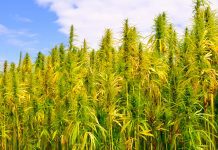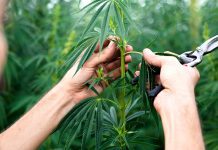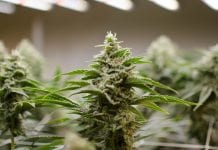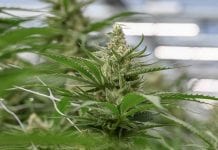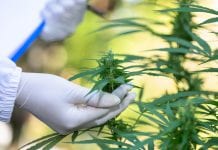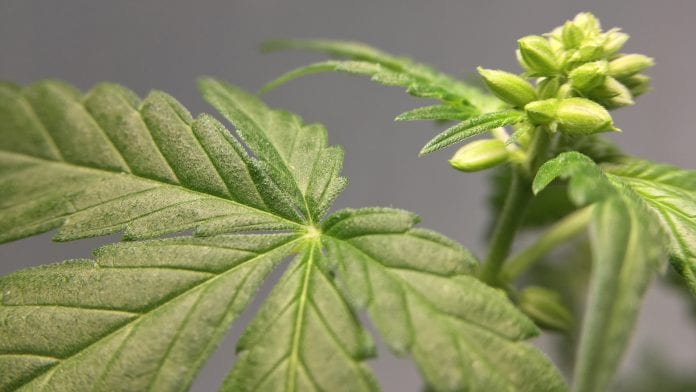
Light is one of the most important factors in the professional cultivation of medical cannabis.
The problem with the ongoing debate on the subject of professional plant lighting, however, is that it is currently almost exclusively limited to the topic of energy efficiency. In the following chapters, COMPLED Solutions attempt to put this debate on a firmer footing.
For many decades, few alternatives were available. One of them involved the use of metal halides (MH) as well as fluorescent lamp technology both for the propagation and the vegetative phase and combined with high-pressure sodium (HPS) for the flowering phase.
Another method that has become widespread in recent years is the use of ceramic metal halide (CMH), as this technology provides a ‘sun like’ lighting.
Since the middle of 2018, LED technology has been increasingly gaining a foothold in the field of professional cannabis cultivation. The reason for this lies not only in the significant efficiency increases thereby achieved but also a considerable easing of the price-performance ratio.
Total cost of ownership calculations are too short sighted
In order to be able to compare different technological approaches with each other, a sensible first step is to calculate the total cost of ownership (TCO) for these different approaches. For this purpose, not only the procurement and operating costs but also the installation and maintenance costs should be included in the calculation. The total costs are then normally calculated for a practice oriented life cycle. In addition, the TCO should be normalised to a defined light output in order to establish comparability.
Current TCO calculations show that modern LED technology can already beat the conventional technologies (HPS and CMH) in relation to the costs. On average, LED technology will break even on a cost basis after 3 or 4 years! The problem with plant lighting, however, is that the light is not an end in itself but only a means to an end. Therefore, not only the costs but also the yields have to be taken into account.
Efficiency vs. effectiveness
As far as ‘establishing’ the light is concerned, plants could hardly care less about efficiency. What they are really interested in is the effectiveness of the light. The effectiveness of the light is essentially determined by the following factors: the intensity, the lighting duration as well as the distribution and spectrum of the light. Here it is not intended to take the lighting duration into account, as this can be regulated for all technologies using the simplest technical means.
The intensity of the light is a major factor in relation to maximising yields. For the cultivation of cannabis, an intensity of 1,000 µmol/m2/s should be typically anticipated. Due to different needs in the various development phases of the plants, the light should also be dimmable. A further important aspect is the interplay between various factors. For example, higher light intensities also necessitate higher CO2 levels, higher temperatures as well as higher amounts of fertiliser. At present, some 1,000 µmol/s can be generated by the most efficient LED technology with approximately 370 watts of electrical energy. In comparison, HPS requires at least 580 watts to do this – and CMH a minimum of 650 watts.
To what extent the light emitted can be exploited by the plants, however, depends – among other factors – on the light distribution or the radiation characteristics of the corresponding lights. In a nutshell, if I light the ceiling instead of the plants, then even the most efficient lighting money can buy is of precious little use to me, since the plants will probably wilt and die. The aim should therefore be to make as much light as possible available for the plants to exploit. For this purpose, manufacturers of plant lighting mostly make use of secondary optics, such as lenses and reflectors in order to direct as much of the light as possible onto the target surface without any loss. In particular, light loss in walls and aisles/passages should thereby be minimised.
One problem in this regard, however, is the fact that lighting concepts in commercial horticulture are traditionally optimised to target surfaces – similarly to the situation in general lighting. In practice, attempts are therefore mostly made to illuminate a target surface at a defined distance from the light source as uniformly as possible and – as far as possible – without any loss. Plants, however, are not two-dimensional objects but three-dimensional living organisms, which compete for the available light and reciprocally shade (or grow into) each other. In this regard, diffuse light possesses a crucial advantage, since it offers a far higher number of angles of incidence of the light, thereby increasing the chance of light penetrating into the gaps between leaves and between plants.
In professional cannabis cultivation, the aim should therefore be to make use of a lighting that is as diffuse as possible in order to optimise the penetration depth of the light and thus maximise its effectiveness and the total surface illuminated. The problem in this regard, however, is that the overall efficiency of the lighting system will drop, because a greater portion of the light emitted will be lost both in walls and aisles/passages.
A further critical – if not the most critical – factor is the spectral composition of the light. Light is more than just a “source of energy” for plants. The composition of the light also provides plants with important information in relation to the time of day or year as well as the location and the competitive environment. To date, over 100 genes and 26 biochemical reaction channels in plants are known to be regulated by light.
A total of at least five groups with a total of 12 known photoreceptors are involved. In addition to the plant architecture (such as size, shape of the plant or its organs), the accumulation of biomass, the immunity and defence strength of plants, the tolerance to stress as well as the production of phytoceuticals are all affected. All of these processes have a significant influence both on the yield and the quality of the end product as well as the production costs. Many plant lighting manufacturers claim to offer the perfect spectrum. Notwithstanding this, however, when taking into account the aforementioned processes as well as the fact that plants have partly varying degrees of adaptability to sunlight – and this also changes dynamically according to time and location, this claim cannot be true. Therefore, until further notice, the ‘perfect’ spectrum of light should be adjustable.
Spectral tuning
The process of photosynthesis is primarily fuelled by light in a wavelength range between 400 and 700 nm. Only a few years ago, blue or red light was primarily relied on, as this can be most efficiently absorbed by the chlorophylls. Furthermore, it was also wrongly assumed for many years that the green component of light is scarcely used by plants. This argument, in particular, was taken up by a large number of LED manufacturers as it fitted in very well with the technical features of LED technology. Even today, LED lighting primarily relying on red and (some) blue light would play a leading role in regard to efficiency and therefore sell the best on the basis of the figures provided in data sheets.
Today, however, solutions that are as far as possible full-spectral in nature have become established. This though, was mostly due to trivial reasons. The principal reason for this is that the use of white LEDs has brought enormous progress in relation to their efficiency and has therefore made it possible for manufacturers with little experience in plant lighting to produce appropriate lighting. The hope in this regard is that optimally full spectral lighting i.e. sun like lighting – will not reveal any negative surprises in relation to their effectiveness.
As already indicated, however, natural sunlight is not static in nature. This means that it changes its spectrum over the course of the day and year, as well as being dependent on the location. Moreover, light is not only a source of energy but also acts as a signal transmitter. A wide range of processes in plants are affected by the different spectral light ranges.
Amongst other things, it is currently known that the blue component of light not only provides for a more compact growth, but also – in combination with UVA radiation by means of the phototropins – influences the movement of chloroplasts, leaf expansion as well as the opening of the stomata and thus the gas exchange of the plant.
Furthermore, these short-wave ranges of the spectrum have an effect on the efficiency of the photosynthesis and can reduce the damage that can be caused by light. Together with phytochromes, which detect light in the red and far red wavelengths (700-800nm), cryptochromes, which also detect UV-A and blue light, influence both the internal clock and the change from the growth to the reproduction phase of the plant.
In the case of a high plant density, the shadows caused by neighbouring plants result in a series of changes in the processes of the plants affected. In this regard, the phytochrome system is also involved, allowing the plant – amongst other things – to detect the degree of shadow caused by changes in the red/infrared component of the light and thereby react to it. Typical reactions include stimulated longitudinal growth, a reduction in leaf development and the development of branching. In addition, there exist other physiological processes in plants, which react to the spectral composition of the light without however, affecting plant growth. For example, UV radiation can – amongst other things – influence the plant’s defence mechanisms.
To date, researchers have discovered 15 different defence proteins in plants, which improve the protection against diseases and parasites. When exposed to high levels of UV radiation, plants also increase their production of antioxidants as a means of protecting themselves against UV radiation. Furthermore, there are indications that UV-B radiation influences the production of cannabinoids, terpenes as well as other secondary metabolites.
This, however, is by no means everything, as the spectrum of light also affects other living organisms, such as algae, pathogens and parasites. For example, this is why research is currently being undertaken into the influence of UV radiation on different parasites.
Although there exists a wide range of possibilities of using the processes described in order to improve yields as well as minimise costs, we must, however, be aware that different genetics can also react in different ways.
Since natural sunlight consists of a large number of spectral components and their distribution varies in relation to time and location, it is essential that the receptors described are partly simultaneously activated. This therefore makes it likely that the reaction of one receptor influences the reaction of another one.
A lighting solution, which is static in relation to the light spectrum, thus invariably runs the risk of influencing the above-mentioned processes to an unfavourable extent or giving rise to undesirable interactions. As the individual processes involved for cannabis have hitherto only been very inadequately studied and their interplay is – to a large extent – still unknown, the ‘perfect’ light spectrum should, for the time being, remain flexibly adjustable.
As far as the adjustability is concerned, the ratios of blue to green to red light as well as from red to infrared are of particular importance. Ideally, the UV component should also be adjustable.
How can medicinal cannabis producers start this R&D process?
R&D processes are normally rather cost-intensive. Not only the personnel costs but also the equipment required is typically not cheap. The cannabis industry, however, is in a special position in this regard. Thanks to the high annual gross proceeds per m2, a self-financing R&D process is at least partly possible, since the flower mass produced as part of the development of lighting or growing recipes is also marketable. In order to start this process, the following is essentially required.
Spectrally adjustable LED lamps must be acquired. In this respect, manufacturers, such as Heliospectra from Sweden and COMPLED Solutions GmbH from Germany can be named. In general, it is also important to pay attention to maximum flexibility in the adjustability of the spectrum as well as a maximum possible light output per LED channel. This is important because the effect of different spectral constellations on the development of the plant must be investigated at intensity levels that are as identical as possible, and sufficient power reserves per LED channel are required for this purpose.
Another generally important aspect is to have the means of controlling – or at least maintaining at a constant level – all other environmental parameters within the test plots, in order to be able to exclude possible interactions.
The simplest way to implement test plots is to integrate modified ‘grow tents’ into existing flowering areas. This will ensure that all relevant environmental parameters correspond to those parameters typically prevailing in the flowering areas. Ideally, however, ‘licensed producers’ (LPs) should install separate climate chambers independently of the existing infrastructure, which can be used for this kind of testing.
This has the advantage of a significantly greater degree of flexibility in relation to possible experimental scenarios. In addition, it is also recommended that as many parameters as possible be recorded either by the use of sensors or by the employees there. The larger the data basis, the better is the subsequent identifying of causalities. A further important aspect is the repetition of tests as well as a randomisation. In general, it is recommended that a minimum of three randomised repetitions per test be performed.
A wide range of aspects can be tested. It is advisable to start with the effect of morphological aspects on the yields. The first step in this regard is the investigation of different blue-green-red constellations. From these tests, it is possible to determine – amongst other things – a maximum yield per unit area for each of the cultivation methodologies used.
Furthermore, the various lighting systems available on the market can subsequently be evaluated in relation to the potential performance of each of the spectra. A next step would be, for example, the investigation of far-red light on the efficiency of the photosynthesis (Emerson effect) on the flower development and the timing of the flowering. Another step might then consist of considering the possibilities of influencing/controlling the cannabis content production.
Conclusion
The purchase of a modern plant lighting system is a not insignificant investment and therefore should be made advisedly. Decisions solely based on energy efficiency and acquisition costs should be avoided. The usual comparative tests of different lighting systems mostly fall far short of what is required.
The problem with this is that the interactions of the lighting with the other environmental parameters are usually not adequately considered. Furthermore, such tests ought to be repeated often enough so that it would be possible to derive causalities with a high degree of certainty.
In point of fact, producers of medical cannabis should address the basic principles of plant lighting and for this purpose create the appropriate R&D capacities. This is particularly necessary in view of the fact that different genetics react differently to differing constellations of light. It is only the corresponding basic understanding in relation to the influence of light on the various processes in plants as well as on the interplay of all relevant environmental parameters that allows both the highest quality standards and the competitiveness of medical cannabis producers to be secured on a long-term basis.
Christoph Schubert
Executive Managing Director
COMPLED Solutions GmbH
+49 351 873234 02
c.schubert@compled-solutions.de
Tweet @CompledG
www.compled.de/index.html




